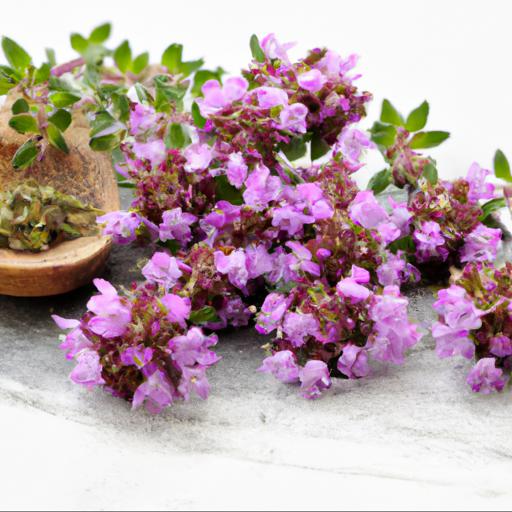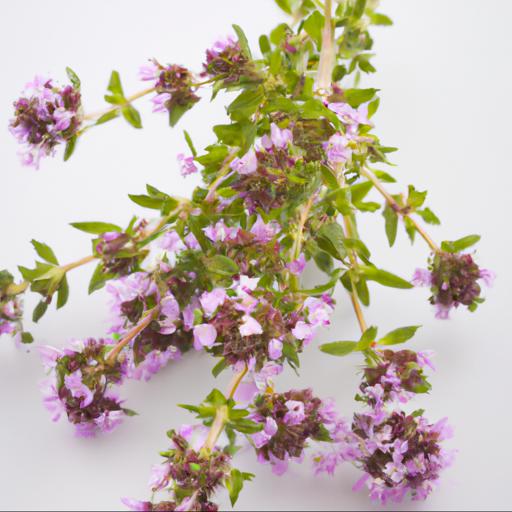Thymus serpyllum, commonly known as wild thyme, is an aromatic herb native to Europe, North Africa and parts of Asia. It is a low-growing, creeping shrub with small, aromatic leaves and lilac-pink flowers. Wild thyme has been used for centuries for its medicinal properties and is still used today to treat a variety of ailments.
It is known to have antiseptic, antispasmodic and anti-inflammatory properties and is used to treat respiratory problems, digestive issues, skin conditions and even menstrual cramps. It can also be used to boost the immune system and improve circulation.
The essential oils of wild thyme have also been used in aromatherapy to relax and soothe the mind.
Benefits of thymus serpyllum

Thymus serpyllum, commonly known as ‘wild thyme’, is an evergreen plant which is native to Europe, Asia and North Africa and widely cultivated around the world due to its many benefits. This plant has been widely used in medicine and cooking for centuries, and is even referenced in ancient Greek literature.
It is particularly valued by UK gardeners, who use its fragrant foliage, pinkish flowers, and attractive overall look to create amazing garden displays. Wild thyme has a wide range of benefits, both in the garden and as a culinary herb. In the garden, its fast growth, drought resistance and ground cover capabilities make it ideal for edging flowerbeds and replacing grass.
Its low height is also perfect for areas of the garden that need extra ground cover without the tall stems or large leaves of other plants. Its flowers attract different species of insects, such as butterflies and moths, bringing welcome wildlife and an extra dash of color. The herb also emits a subtle and pleasant scent, meaning it can be used in place of traditional, chemical air fresheners.
In cooking, wild thyme is highly versatile. It can be used fresh or dried, adding flavors to soups, sauces, salads and egg dishes.
Its strong flavor makes it a perfect edition to roasted and grilled vegetables, and is also great for adding a special twist to cheese dishes. The herb has also been used for centuries in the making of herbal teas, used to help relieve cold, flu and digestive issues. Wild thyme also contains various vitamins and minerals, such as iron, potassium and vitamin A, meaning that it is not just a great flavoring agent, but also a fantastic and natural way to add more nutrients to your meals.
Overall, it is clear that wild thyme, or Thymus serpyllum, can offer a number of great benefits to both your garden and your cooking. Its fast growth and attractive foliage make it a must-have for any landscaping enthusiast, while its flavor, fragrance and considerable vitamin and mineral content makes it the perfect addition to any kitchen.
Whether you are gardening, cooking or just looking for a natural way to freshen the air, adding wild thyme to your repertoire is guaranteed to be a great decision.
Growing thymus serpyllum

Gardening can be a relaxing and satisfying hobby that lets you unleash your creativity and enjoy the beauty of the outdoors. Thymus serpyllum, commonly known as wild thyme, is an attractive herb that produces a beautiful aroma and offers a diverse range of uses. This low-growing evergreen shrub not only requires minimal maintenance but is also drought-tolerant and pest-resistant, making it an ideal choice for UK gardeners.
Propagating and cultivating wild thyme is quite simple, making it the perfect beginner’s plant. When selecting wild thyme, look out for profuse flowering and bright green foliage, as this is indicative of a healthy plant that will flourish in your garden.
Additionally, you must choose whether you’d like to opt for the creeping or upright form of wild thyme. Once in the ground, keep wild thyme well-irrigated, but beware of overwatering as this may lead to root rot. Every spring, apply a light layer of mulch to help retain moisture in the soil.
This herb requires almost no pruning and is quite drought-tolerant, but you can choose to prune off the old, dead growth if you want the plant to look attractive. Wild thyme makes a wonderful addition to any garden and is a great plant to introduce to more experienced gardeners looking for a low-maintenance beauty.
When cultivated correctly, it can provide a wealth of texture and gorgeous blue-violet flowers that emit a sweet aroma. This versatile shrub also does well in rock gardens and pots, offering a range of uses and an attractive aesthetic to any garden.
Uses of thymus serpyllum

The perennial Thymus serpyllum is part of a family of aromatic blossoming herbs that have been used in folk medicine for centuries. It is commonly referred to as “wild thyme”, though there are many species in the thymus genus.
When it comes to gardening, Thymus serpyllum is an ideal choice because it is easy to care for and widely available. Not only is it not difficult to maintain, it also has attractive foliage and a long lifespan, making it an attractive addition to any garden. This herbaceous trailing plant is low growing and mat-forming, and can be grown in a variety of conditions anywhere from full sun to partial shade.
In addition to being an eye-catching addition to a garden, Thymus serpyllum is also an incredibly versatile herb. It has anti-bacterial and anti-fungal properties and is often used to make herbal teas, adding a wonderful flavor to them.
The essential oil can be used in a variety of ways, from tinctures and salves to massage oils and vapor rubs, and can be used to treat a variety of ailments. The leaves can be eaten in salads or cooked for a delicious green on the table. They can also be used in breads or cooked into sauces or other dishes.
Thymus serpyllum also has a history of being used for spiritual practices, and can be burned as incense to invoke a calming atmosphere and help meditations go more smoothly. No matter what kind of garden you have, you’ll find lots of uses for Thymus serpyllum. With its attractive foliage and wide range of applications, it won’t be hard to find a place to grow this versatile plant.
Whether you’re looking for an eye-catching addition to your garden, an herbal remedy, or just a delicious green to add to your table, Thymus serpyllum won’t disappoint.
Final Touch
Thymus serpyllum, commonly known as wild thyme, is a species of flowering plant in the mint family. It is native to Europe, North Africa, and parts of Asia. Wild thyme is an evergreen perennial, growing to a height of 10 cm and is an excellent ground cover for rock gardens and paths.
Its leaves are strongly scented and can be used in cooking and herbal medicine. It is also a popular ornamental plant due to its attractive flowers and foliage.
Wild thyme is easy to grow and requires full sun and well-drained soil.
FAQ
What are the common names for Thymus serpyllum?
Common names for Thymus serpyllum include wild thyme, creeping thyme, mother of thyme, and wild creeping thyme.
What are the medicinal uses of Thymus serpyllum?
Thymus serpyllum has many medicinal uses, including treating respiratory conditions, digestive issues, skin problems, and even cancer. It is known to have anti-inflammatory, antiseptic, and antiviral properties. It is also used to improve the immune system, reduce stress, and improve circulation.
What is the scientific classification of Thymus serpyllum?
Thymus serpyllum is classified as a flowering plant in the family Lamiaceae, genus Thymus, and species serpyllum.
What are the chemical constituents of Thymus serpyllum?
The chemical constituents of Thymus serpyllum include thymol, carvacrol, geraniol, linalool, and other terpenes.
What are the environmental conditions required for Thymus serpyllum to grow?
Thymus serpyllum requires full sun and well-drained soil to grow. It prefers a neutral to slightly alkaline soil, and can tolerate drought and poor soils.
What are the potential side effects of consuming Thymus serpyllum?
The potential side effects of consuming Thymus serpyllum include nausea, vomiting, dizziness, headache, and increased heart rate. It may also interact with certain medications, so it is important to consult with a healthcare professional before taking it.

